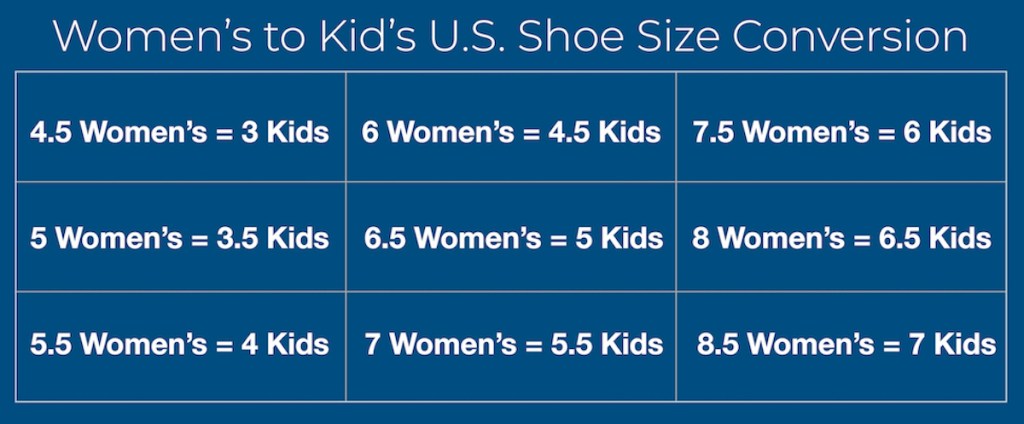Women's Youth Shoe Sizes Guide

Understanding women’s youth shoe sizes can be a bit challenging, especially for parents or guardians trying to find the perfect fit for their growing children. Shoe sizes for youth can vary significantly between brands and styles, making it essential to have a comprehensive guide to ensure the best fit. In this article, we will delve into the world of women’s youth shoe sizes, exploring the different size charts, conversion methods, and tips for finding the ideal shoe.
Introduction to Women’s Youth Shoe Sizes
Women’s youth shoe sizes cater to girls who have outgrown children’s sizes but are not yet ready for adult sizes. This category typically includes shoe sizes from 4 to 6.5 in U.S. sizing. However, the exact range can slightly vary depending on the shoe brand and style. It’s crucial to note that youth shoe sizes are designed to accommodate the unique foot shape and growth patterns of young girls, providing the necessary support and comfort.
Size Charts and Conversion
To navigate the world of women’s youth shoe sizes effectively, it’s helpful to understand how they relate to other sizing systems. The most common systems include U.S., U.K., European, and Japanese sizes. Each system has its own measurements and size intervals, which can sometimes lead to confusion when trying to find the right size across different brands or regions.
- U.S. Sizes: Ranges from 4 to 6.5 for youth, with half sizes available for more precise fits.
- U.K. Sizes: Aligns closely with U.S. sizes but starts from a size 3 (equivalent to a U.S. size 4) and goes up to 5.5.
- European Sizes: Uses a numbered system starting from 35 (equivalent to a U.S. size 4) up to 38.5, offering a slightly different scale.
- Japanese Sizes: Typically runs smaller than U.S. sizes, starting from 21.5 cm (equivalent to a U.S. size 4) and going up, with measurements based on the length of the foot in centimeters.
Tips for Finding the Right Fit
- Measure Their Feet: Use a ruler or a foot measuring device to get the exact length of your child’s foot. Compare this measurement with the shoe brand’s size chart to find the best fit.
- Consider the Width: Some brands offer different widths (narrow, medium, wide), which is crucial for comfort and to prevent foot problems.
- Try Them On: If possible, have your child try on shoes, especially if you’re unsure about the size. This ensures the shoe fits well and is comfortable.
- Account for Growth: Buy shoes that offer a bit of room for growth, but not so much that they cause the child to trip or lose balance.
- Check the Return Policy: Some brands offer generous return policies, which can be a lifesaver if the shoes don’t fit as expected.
Brands and Styles
Different brands cater to various tastes, activities, and budgets. From athletic wear like Nike and Adidas to more casual, everyday shoes from Converse or Vans, each brand may have slightly different sizing. It’s essential to check the specific size chart for each brand to ensure the best fit.
Health Considerations
Wearing shoes that are too small or too large can lead to foot health issues, including blisters, ingrown toenails, and long-term problems like bunions or hammertoes. It’s vital to prioritize shoe fit to prevent these issues and ensure comfort and support throughout the day.
Conclusion
Finding the right women’s youth shoe size involves understanding the different sizing systems, measuring feet accurately, and considering factors such as width and growth room. By following the tips and guidelines outlined above, parents and guardians can navigate the complex world of shoe sizes with confidence, ensuring their child’s feet are well-supported and comfortable throughout their daily activities.
How often should I measure my child's feet for shoe sizes?
+Feet can grow rapidly during childhood, so it's a good idea to measure them every 2-3 months, especially during growth spurts, to ensure the shoes are not too tight or too loose.
Can I use a shoe size chart from one brand for another?
+While shoe size charts might seem similar, there can be variations between brands due to differences in design, material, and intended use. It's best to use the size chart provided by each specific brand for the most accurate fit.
How do I know if a shoe is too tight or too loose for my child?
+A shoe that is too tight can cause discomfort, redness, or blisters. A shoe that is too loose can cause tripping or slipping out of the shoe. The ideal fit should allow for about a thumb's width between the end of the longest toe and the shoe's end when the child is standing up.
Understanding and navigating women’s youth shoe sizes require patience, attention to detail, and a bit of flexibility. By staying informed and adapting to the changing needs of growing feet, you can offer your child the best possible support and comfort in their shoes, setting them up for a lifetime of healthy, happy feet.


